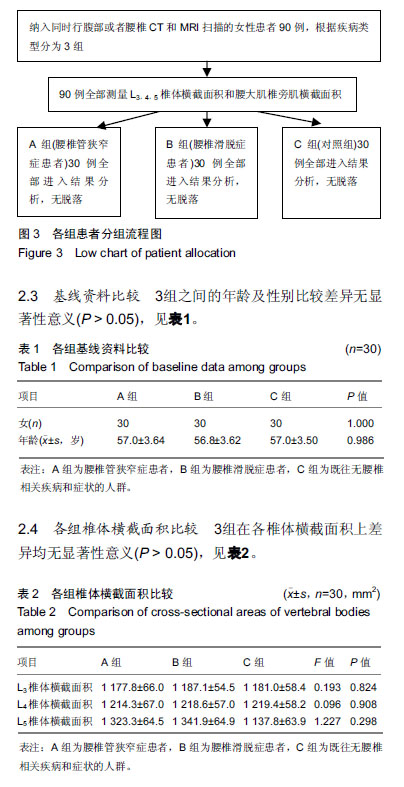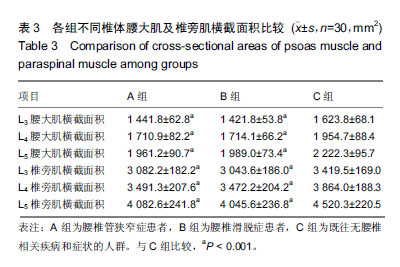| [1]Wagner H, Anders CH, Puta CH, et al. Musculoskeletal support of lumbar spine stability. Pathophysiology.2005;12(4):257-265.[2]Ward SR, Kim CW, Eng CM, et al. Architectural analysis and intraoperative measurements demonstrate the unique design of the multifidus muscle for lumbar spine stability. J Bone Joint Surg Am. 2009;91(1): 176-185.[3]Freeman MD, Woodham MA, Woodham AW. The role of the lumbar multifidus in chronic low back pain: a review. PM R. 2010;2(2):142-146.[4]Vives MJ. The paraspinal muscles and their role in the maintenance of global spinal alignment. Another wrinkle in an already complex problem. Spine J. 2016;16(4): 459-461.[5]Regev GJ, Kim CW, Tomiya A, et al. Psoas muscle architectural design, in vivo sarcomere length range, and passive tensile properties support its role as a lumbar spine stabilizer. Spine (Phila Pa 1976). 2011; 36(26): E1666-E1674.[6]Andersson EA, Grundström H, Thorstensson A. Diverging intramuscular activity patterns in back and abdominal muscles during trunk rotation. Spine (Phila Pa 1976). 2002;27(6): E152-160.[7]Ng JK, Richardson CA, Jull GA. Electromyographic amplitude and frequency changes in the iliocostalis lumborum and multifidus muscles during a trunk holding test. Phys Ther. 1997;77(9): 954-961.[8]Mannion AF, Käser L, Weber E, et al. Influence of age and duration of symptoms on fibre type distribution and size of the back muscles in chronic low back pain patients. Eur Spine J. 2000;9(4): 273-281.[9]韦以宗,田新宇,王慧敏,等. 腰大肌与腰椎运动力学关系动物实验研究[J]. 中国临床解剖学杂志, 2011, 29(1): 97-99.[10]Eguchi Y, Suzuki M, Yamanaka H, et al. Associations between sarcopenia and degenerative lumbar scoliosis in older women. Scoliosis Spinal Disord. 2017;12: 9.[11]Ranger TA, Cicuttini FM, Jensen TS, et al. Are the size and composition of the paraspinal muscles associated with low back pain? A systematic review. Spine J. 2017;17(11): 1729-1748.[12]朱康,孙根文,乔培柳,等. 椎旁肌横截面积变化可导致退行性腰椎滑脱[J]. 中国组织工程研究,2014,18(9):1392-1397.[13]Ravindra VM, Senglaub SS, Rattani A, et al. Degenerative lumbar spine disease: estimating global incidence and worldwide volume. Global Spine J. 2018;8(8): 784-794.[14]Hu ZJ, He J, Zhao FD, et al. An assessment of the intra- and inter-reliability of the lumbar paraspinal muscle parameters using CT scan and magnetic resonance imaging. Spine (Phila Pa 1976). 2011;36(13): E868-874.[15]Suh DW, Kim Y, Lee M, et al. Reliability of histographic analysis for paraspinal muscle degeneration in patients with unilateral back pain using magnetic resonance imaging. J Back Musculoskelet Rehabil. 2017; 30(3): 403-412.[16]Ranson CA, Burnett AF, Kerslake R, et al. An investigation into the use of MR imaging to determine the functional cross sectional area of lumbar paraspinal muscles. Eur Spine J. 2006;15(6): 764-773.[17]Society NAS. Diagnosis and Treatment of Degenerative Lumbar Spondylolisthesis 2nd Edition. North American Spine Society, 2014. 2nd Edition.[18]Society NAS. Diagnosis and Treatment of Degenerative Lumbar Spinal Stenosis. North American Spine Society, 2011.[19]Barker KL, Shamley DR, Jackson D. Changes in the cross-sectional area of multifidus and psoas in patients with unilateral back pain: the relationship to pain and disability. Spine (Phila Pa 1976). 2004;29(22): E515-519.[20]Landi A, Gregori F, Marotta N, et al. Hidden spondylolisthesis: unrecognized cause of low back pain? Prospective study about the use of dynamic projections in standing and recumbent position for the individuation of lumbar instability. Neuroradiology. 2015; 57(6): 583-588.[21]Arbanas J, Pavlovic I, Marijancic V, et al. MRI features of the psoas major muscle in patients with low back pain. Eur Spine J. 2013; 22(9): 1965-1971.[22]Modic MT, Ross JS. Lumbar degenerative disk disease. Radiology. 2007;245(1): 43-61.[23]Hides J, Gilmore C, Stanton W, et al. Multifidus size and symmetry among chronic LBP and healthy asymptomatic subjects. Man Ther. 2008;13(1): 43-49.[24]Dangaria TR, Naesh O. Changes in cross-sectional area of psoas major muscle in unilateral sciatica caused by disc herniation. Spine (Phila Pa 1976). 1998;23(8): 928-931.[25]Franke J, Hesse T, Tournier C, et al. Morphological changes of the multifidus muscle in patients with symptomatic lumbar disc herniation. J Neurosurg Spine. 2009;11(6): 710-714.[26]Wan Q, Lin C, Li X, et al. MRI assessment of paraspinal muscles in patients with acute and chronic unilateral low back pain. Br J Radiol. 2015;88(1053): 20140546.[27]Yalt?r?k K, Güdü BO, I??k Y, et al. Volumetric muscle measurements indicate significant muscle degeneration in single-level disc herniation patients. World Neurosurg. 2018; 116: e500-e504.[28]Matz PG, Meagher RJ, Lamer T, et al. Guideline summary review: An evidence-based clinical guideline for the diagnosis and treatment of degenerative lumbar spondylolisthesis. Spine J. 2016;16(3): 439-448.[29]闫广辉,李志赏,赵磊,等. 退行性腰椎滑脱症患者椎旁肌变化的影像学分析[J]. 中国临床研究, 2017, 30(4): 509-511.[30]Jayakumar P, Nnadi C, Saifuddin A, et al. Dynamic degenerative lumbar spondylolisthesis: diagnosis with axial loaded magnetic resonance imaging. Spine (Phila Pa 1976). 2006;31(10): E298-301.[31]Wang G, Karki SB, Xu S, et al. Quantitative MRI and X-ray analysis of disc degeneration and paraspinal muscle changes in degenerative spondylolisthesis. J Back Musculoskelet Rehabil. 2015;28(2): 277-285.[32]闫广辉,高春光,李华,等. 腰椎小关节三维角度与退行性腰椎滑脱症的相关性研究[J]. 实用放射学杂志, 2015,31(5): 810-812.[33]Morimoto M, Higashino K, Manabe H, et al. Age-related changes in axial and sagittal orientation of the facet joints: Comparison with changes in degenerative spondylolisthesis. J Orthop Sci. 2019;24(1):50-56.[34]Liu X, Zhao X, Long Y, et al. Facet sagittal orientation: possible role in the pathology of degenerative lumbar spinal stenosis. Spine (Phila Pa 1976). 2018;43(14): 955-958.[35]Ramhmdani S, Ishida W, Perdomo-Pantoja A, et al. Synovial cyst as a marker for lumbar instability: a systematic review and meta-analysis. World Neurosurg. 2019;122:e1059-e1068.[36]乔培柳,塔依尔•阿不都哈德尔. 腰椎退行性疾病椎旁肌的渐进变化[J]. 中国组织工程研究, 2014,18(44): 7205-7210.[37]Wagner SC, Sebastian AS, McKenzie JC, et al. Severe lumbar disability is associated with decreased psoas cross-sectional area in degenerative spondylolisthesis. Global Spine J. 2018; 8(7): 716-721.[38]Lescher S, Bender B, Eifler R, et al. Isometric non-machine-based prevention training program: effects on the cross-sectional area of the paravertebral muscles on magnetic resonance imaging. Clin Neuroradiol. 2011; 21(4): 217-222.[39]Sun D, Liu P, Cheng J, et al. Correlation between intervertebral disc degeneration, paraspinal muscle atrophy, and lumbar facet joints degeneration in patients with lumbar disc herniation. BMC Musculoskelet Disord. 2017;18(1): 167.[40]Crawford RJ, Elliott JM, Volken T. Change in fatty infiltration of lumbar multifidus, erector spinae, and psoas muscles in asymptomatic adults of Asian or Caucasian ethnicities. Eur Spine J. 2017;26(12): 3059-3067.[41]Crawford RJ, Volken T, Valentin S, et al. Rate of lumbar paravertebral muscle fat infiltration versus spinal degeneration in asymptomatic populations: an age-aggregated cross-sectional simulation study. Scoliosis Spinal Disord. 2016; 11: 21.[42]Kjaer P, Bendix T, Sorensen JS, et al. Are MRI-defined fat infiltrations in the multifidus muscles associated with low back pain? BMC Med. 2007; 5: 2.[43]Teichtahl AJ, Urquhart DM, Wang Y, et al. Fat infiltration of paraspinal muscles is associated with low back pain, disability, and structural abnormalities in community-based adults. Spine J. 2015; 15(7): 1593-1601. |
.jpg)
.jpg)



.jpg)